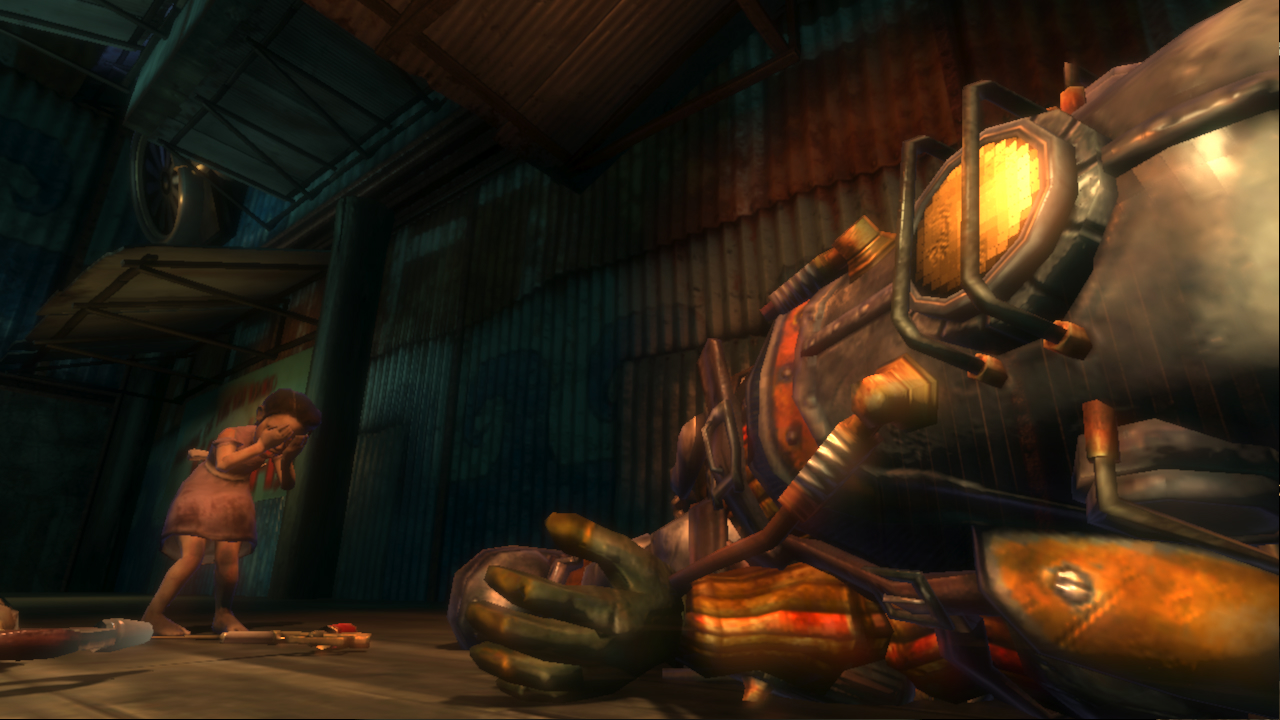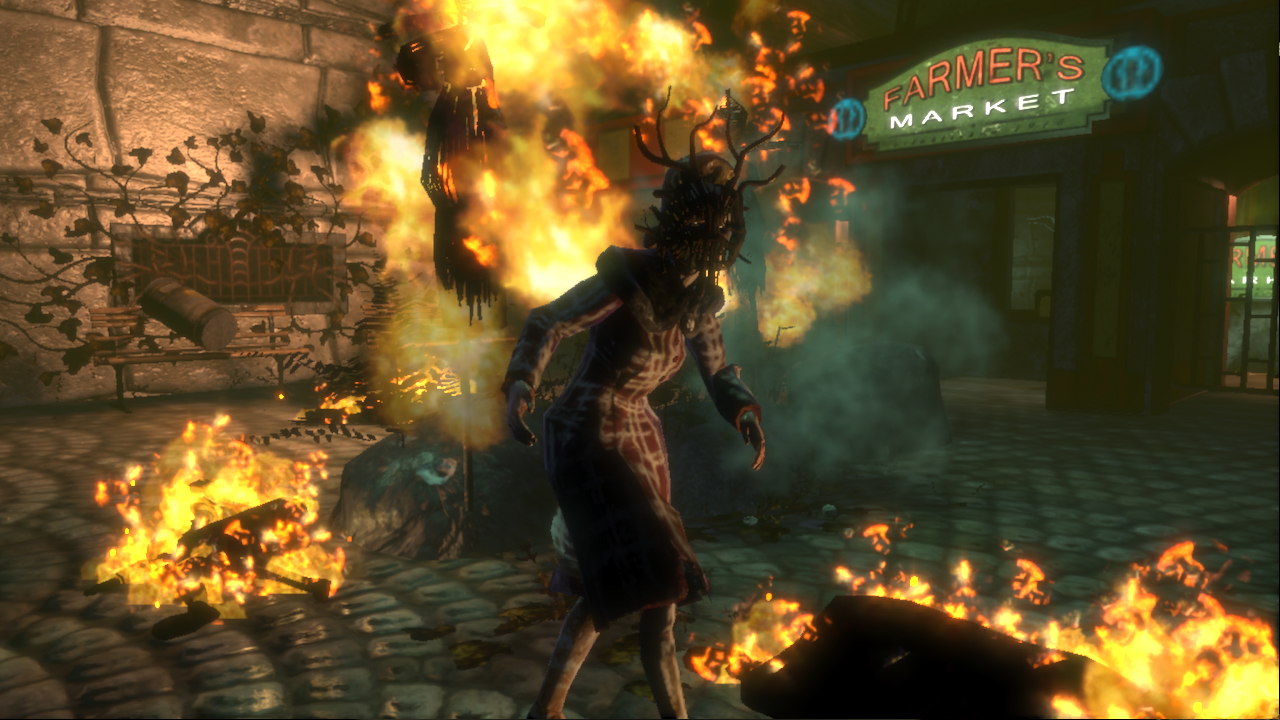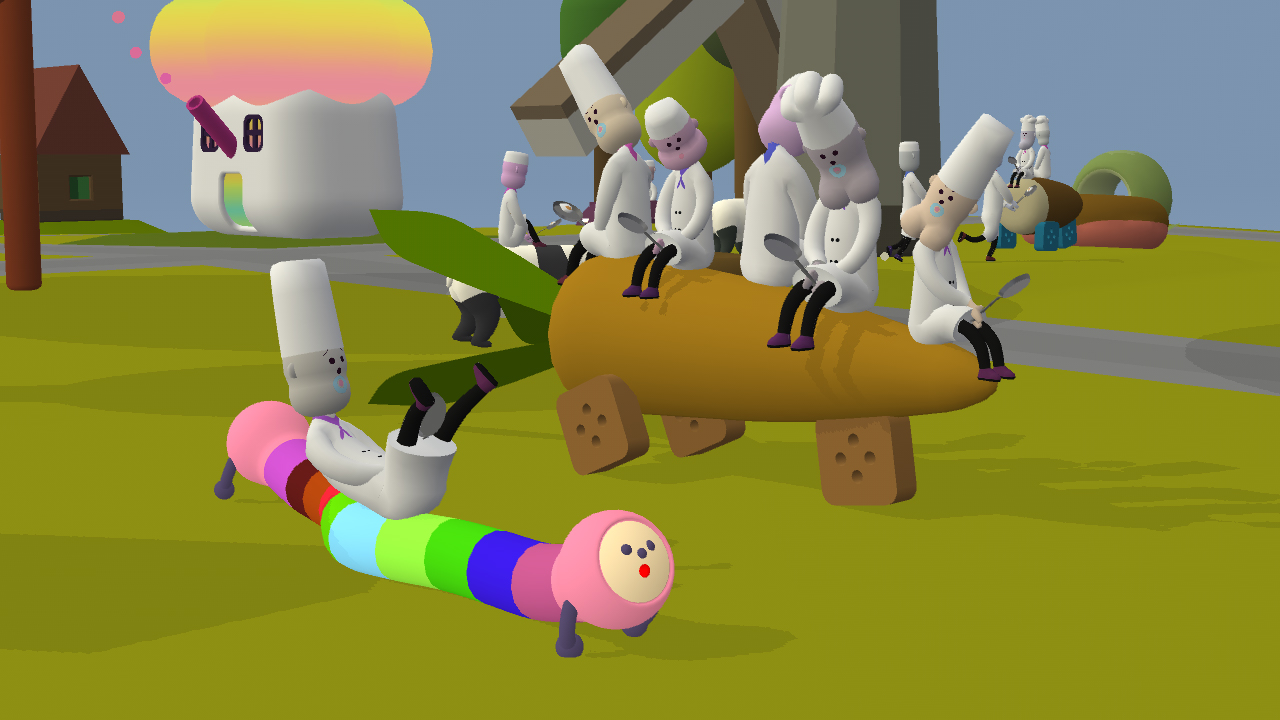
Limitations of Little Sisters: The Tyranny of Fun
Salvatore Pane questions the value of fun in videogames.
In 2013, I walked into a screening of Harmony Korine’s subversive Spring Breakers with my fiancée and a flask of cheap bourbon hidden in my coat. 94 minutes later, I left stupefied and unsettled, bourbon barely sipped. Spring Breakers is a masterful piece of postmodern cinema taking the images and melodies deemed reassuring by corporate youth media—topless co-eds shotgunning cheap beer on golden beaches, and the money-obsessed, drug-glorifying lyrics of over-the-top personalities like Riff Raff—and repackaging them into something truly grotesque. Korine is a veteran of unsettling cinema like Gummo, Trash Humpers, and ‘90s AIDS anthem Kids. In a similar vein, Spring Breakers orbits around a foursome of fresh-faced teen girls in a non-linear narrative about exploitation, race, class, media representation, and gender. The film’s cleverest scene, an absurd montage of James Franco—portraying the Riff Raff-esque Alien—pecking Britney Spears’ “Every Time” on piano surrounded by three of the buxom, masked teens is cut against images of their gang terrorizing a Florida beach town with dizzying violence. Spring Breakers is smart and refreshing and most definitely art if we can all agree that art doesn’t necessarily have to entertain, but can instead focus entirely on satire or other political ends.
My fiancée hated Spring Breakers. As is so often the case, we left the movie engaged in fierce conversation. She agreed the film made valid points about many social issues but argued that Spring Breakers was so actively concerned with being unsettling that it failed to be an enjoyable experience. The incessant nudity and dream-like quality of the narrative completely pulled her out, and I can’t say I blame her. She grew up on movie musicals and the films of the 1930’s, and to this day her favorite movie remains the unbelievably nerdy 1776, a feel-good musical about the creation of the Declaration of the Independence. I grew up on trash, on Godzilla marathons and the deep cuts of the then Sci Fi Channel. I was the weird little goober that rushed to see Weekend at Bernie’s II or Bill and Ted’s Bogus Journey on opening nights. Enjoying movies for their content has always been beside the point. Right from the start they were cultural objects whose true pleasure derived from long, reflective conversation and deep analysis. I love surface-enjoyable films like Star Wars as much as the next red-blooded American, but on the drive back to our apartment, I argued that unsettling and anxiety-inducing art like Spring Breakers is necessary. It balanced the scales against the Paul Blarts and Fast and Furiouses of the world. Many have argued that art’s moral imperative is to challenge. By that criteria, Spring Beakers succeeds.
She agreed with that broad point, but now I’m not sure if I do. I’m more than willing to accept anxiety from films or books, but not with video games. I’ve been a gamer all my life, ever since Christmas 1989 when I unwrapped the outer space glory of the Nintendo Entertainment System. I collect NES games, I write about games, I even teach New Media at the University of St. Thomas. And yet I still don’t extend the same benefit of the doubt to games that I do to movies or books.
 II
II
The original BioShock was released in August 2007, but I didn’t play it until eight years later. BioShock was released three months after I graduated college. I had access to almost zero income or financial support. I couldn’t afford to buy BioShock, let alone the shiny new consoles required to play it. Since I finally purchased a PlayStation 3 in 2014, I’ve been playing my way through that generation’s best and brightest games, a crash course in how dramatically things have changed since PlayStation 2, when I spent hours memorizing Zone of the Enders or Final Fantasy X.
In terms of narrative and atmosphere, BioShock is one of the most ambitious games I’ve ever experienced. Set in 1960, you control the first-person vantage point of Jack, whose plane crashes in the middle of the ocean. After the briefest of introductions, you find yourself in Rapture, an underwater city inspired by conservative icon Ayn Rand. Founded by Andrew Ryan, a 1940s Objectivist tycoon, Rapture is intended to be a utopia that stands separate from the worlds of government and religion, a place uncolonized by the tyrannies of the state or the preacher.
The actual gameplay of BioShock is that of the traditional first-person shooter dating all the way back to Id Software’s Doom and Return to Castle Wolfenstein. But BioShock manages to address its philosophical quandaries in its gameplay in ways those games never did. Rapture is littered with Little Sisters, children unsuccessfully experimented on now wandering the ruined city like sickly ghosts. They are protected by beings known as Big Daddies—yes, it’s beyond uncomfortable—who schlep around Rapture in large robotic diving suits armed to the teeth. Whenever you encounter a Little Sister and Big Daddy—which is quite often throughout the campaign—you’re presented with a set of ethical choices. Little Sisters possess ADAM, the Force-like magic that grants extremely powerful abilities. You could choose to ignore Little Sisters entirely, but that would leave you weakened for many of the game’s more challenging sections. The game stresses that your best course of action is to kill the Big Daddy, then either harvest or save the Little Sister. Harvest her, and you’re presented with a scene of shockingly gruesome violence in which Jack drives his fist into the child’s flesh and rips out something resembling a gooey tentacle. Save her, and the Little Sister is transformed back into a grinning child unaware that she’s trapped inside an underwater maze of terrors and ghouls.
The question is this: given the above, why wouldn’t you save the Little Sisters? BioShock literalizes the questions behind Ayn Rand’s philosophies: do humans value selfishness and self-preservation over altruism? If you murder a Little Sister, you’re rewarded with more ADAM, which means more destructive powers, which means an easier game. If you save a Little Sister, you’re given much less. Thus, the player must decide for themselves if they’ll walk the path of the Randian anti-hero or the secular humanist.
 BioShock is a noble experiment, but one that immediately fails when compared to books and films with similar aims. The haunting philosophical questions above are completely undone as the game rewards you for every three Little Sisters you save. Even though you are told the path to power lies through the corpses of children, any reasonably seasoned gamer senses that the game’s true ending can only be viewed by saving every Little Sister and that you can become stronger by never harvesting a single one. This ludic disconnect renders the entire philosophical experiment inert, but it’s still an important stepping stone toward video games developing a narrative language inherent to their own medium. 2K Boston, the developer, is not gaming’s Orson Welles, just like BioShock isn’t Citizen Kane. Perhaps they’re more like the Lumière brothers, and BioShock is 1902’s A Trip to the Moon, a tantalizing hint of all the glory yet to come.
BioShock is a noble experiment, but one that immediately fails when compared to books and films with similar aims. The haunting philosophical questions above are completely undone as the game rewards you for every three Little Sisters you save. Even though you are told the path to power lies through the corpses of children, any reasonably seasoned gamer senses that the game’s true ending can only be viewed by saving every Little Sister and that you can become stronger by never harvesting a single one. This ludic disconnect renders the entire philosophical experiment inert, but it’s still an important stepping stone toward video games developing a narrative language inherent to their own medium. 2K Boston, the developer, is not gaming’s Orson Welles, just like BioShock isn’t Citizen Kane. Perhaps they’re more like the Lumière brothers, and BioShock is 1902’s A Trip to the Moon, a tantalizing hint of all the glory yet to come.
None of this explains why I—a self-professed torchbearer of gaming’s unlimited potential—gave up on BioShock less than halfway through the single-player campaign. Although the narrative is dotted with intriguing philosophical concerns, the actual gameplay is positively retrograde and reminiscent of older first-person shooters. Rapture is full of terrifying mutants but light on the bullets. You must conserve your ammo and ADAM to survive, and every new room or hallway has the potential for a jump scare or creepy encounter. I felt extremely tense while playing BioShock, sitting rigid on the couch, my eyes stuck in unblinking attention. Once, while exploring a particularly quiet stretch of Rapture, I literally jumped when a physical gust of wind slammed a door in my house.
I survived until Rapture’s theatre district, where you encounter a mutant chained to a piano trying to apply the instructions of an unseen stage director. The mutant fails again and again, until the piano abruptly explodes, an act of lustful violence on the part of the stage director. He then instructs you to snap a photograph of the smoldering dead body, hang it up on a makeshift art installation nearby, and then do the same to a handful of other mutant thespians. There is absolutely nothing fun about photographing a dead body and displaying the results as art. My avatar wandered aimlessly around the theatre, avoiding his gruesome task, until it dawned on me that I wasn’t having any fun. BioShock is compelling, it’s interesting, it’s deep for a video game, but for me, it isn’t fun. I didn’t look forward to playing it, and instead, viewed the possibility of more time in Rapture the same way I blink at my sun-faded lawnmower when it’s time to cut the grass. BioShock had become a chore. It ceased to be fun, and I haven’t played it since that gloomy day in Rapture’s theatre.
And yet I love Spring Breakers even though there isn’t a single fun frame in the entire film. I adore difficult books like Nabokov’s Pale Fire or Matt Bell’s In the House Upon the Dirt Between the Lake and the Woods even though those works seem to possess an actual distaste for the very concept of fun. Why can’t I extend that same luxury to games?
 III
III
If media like Spring Breakers and BioShock exist on one side of the anxiety/fun spectrum, controller-hurling video games like Mega Man or even the far simpler Super Mario Bros. exist somewhere in the middle. Anxiety is induced in the player not through fear or atmosphere as in BioShock, nor via graphic reworkings of pop culture’s sexual norms like in Spring Breakers, but through the difficulty of an impending miracle jump or bout with a fierce Robot Master. That difficulty produces anxiety, but unlike in BioShock, games like the aforementioned Super Mario Bros. and Mega Man cut that sensation with cheery visuals and upbeat music, the 8-bit iconography of fun. Now, if Super Mario Bros. and Mega Man stand in the middle of the spectrum, the spectacular failure Noby Noby Boy would exist on the outermost edges, a galaxy away from media like Spring Breakers or BioShock.
Noby Noby Boy is the 2009 spiritual successor to the Katamari Damacy series, a PlayStation 2 piece of Japanese power pop, that sees you taking control of the Prince who must clean up the King of All Cosmos‘ drunken bender. This is accomplished by rolling a sticky ball or Katamari, and picking up paperclips, batteries, screaming humans, mewling cats, and by game’s end, skyscrapers and even gods. The game is broken up into a series of short, timed levels of near perfectly attuned difficulty, and everything is bathed in the quirky deadpan glow of anime and J-Pop. It’s a flawless if fluffy title, and if given the option, I’d play Katamari Damacy or one of its sequels over BioShock every single time even though the former says absolutely nothing about Ayn Rand or what it means to be human. Noby Noby Boy, on the other hand, is an utter mess.
Developed by Keita Takahashi after Katamari Damacy for the PlayStation 3, Noby Noby Boy is about a worm named BOY. The game takes place on a series of candy-colored but textureless environments. There aren’t really goals in Noby Noby Boy. You simply stretch your worm as far as it will go. When you’re satisfied with the size of your worm—shout out to Freud!—you submit it to the Sun who hands it to GIRL, a planet-sized goddess. There are no goals or time limits. In Katamari Damacy, if you send a diminutive Katamari to the King of All Cosmos, he chastens his son with the cosmic thunder and lightning of a Jack Kirby-esque space god. Not so in Noby Noby Boy. Big worm, small worm. It doesn’t matter. Noby Noby Boy neutrally records not only the total size of your submitted BOYs, but the collective size of every worm submitted by every player across the entire world. GIRL will tell you the total size of the world’s BOYs in real time, and every few weeks or months, when that collective BOY hits a certain size, a new level unlocks. Noby Noby Boy is a game you play alongside all civilization, or at least everyone with a PlayStation 3 and Noby Noby Boy.
But none of that makes it fun. The utter absence of enemies, time limits, and goals transforms Noby Noby Boy into something that’s only interesting for a few minutes, like a middling phone app or Kraft Macaroni and Cheese. How long can you really stretch your worm before you grow bored? Sure, there are different stages, and the bizarre Japanese visuals—giant roosters, an army of chefs riding a carrot car, the land of donuts—are fairly compelling, if muted when compared to the all-out insanity of Katamari Damacy. Noby Noby Boy, I imagine, is intended to be relaxing, to inspire the exact opposite of something like BioShock or even Spring Breakers. Noby Noby Boy is meandering and meditative. But unlike other media, I still refuse to accept a video game that is not overwhelmingly concerned with the concept of fun ingrained upon me by a legion of Nintendo classics. I played Noby Noby Boy for twenty minutes and will likely never play it again. Gamers are slaves to the tyranny of fun.
 IV
IV
Kellee Santiago’s 2010 TED Talk “Are Video Games Art?” is meant to nudge people into interrogating what kinds of people are allowed authority in not only the art world, but society as well. One of the many compelling questions the Journey developer asks over her fifteen-minute presentation is if video games can one day convey a deeper sense of sadness. I’ve played sad games. Final Fantasy VII has a notoriously low moment. The resolution of Grand Theft Auto IV is intentionally ambiguous and dark. But if art’s moral imperative is to challenge, then video games’ moral imperative—or at least as interpreted by the majority of my generation—is the opposite of sadness: fun. We as gamers and developers are trapped by it. I am more than happy to champion art like Spring Breakers, but hypocritically unwilling to even finish BioShock or Noby Noby Boy simply because they don’t line up with my sophomoric notions of video games.
I have long viewed myself as some kind of champion of video games as a medium, apotheosizing the artistic merits of beloved and formative games like Metal Gear Solid or Earthbound, but my utter disinterest in completing BioShock—or even attempting to play the other games in the franchise—has revealed the harsh truth. I’m part of the second generation of gamers and will always be limited by the artistic prejudices of those who feasted on Super Mario Bros. in pre-school and only glimpsed the artistic potential of later games. Like the first Neanderthals to bear witness to cave paintings, we are dimly aware of the vast artistic potential of the medium, but if a game can’t sniff at the steady fun of a Nintendo platformer, it’s viewed as a failure. Just like initial moviegoers who saw film merely as a vehicle to record and distribute plays, we are doomed by our unfortunate place in history.
It will not be our generation who unlocks the artistic potential of videogames as a medium, it will be the next, the one that grows up on BioShock and Noby Noby Boy, the generation who goes into gaming without any preconceived notions about fun—just like we did with film and books—the generation who arrived when developers like 2K Boston and Keita Takahashi and Kellee Santiago were already seizing the manifest destiny inherent to all forms of human expression and expanding video games into crude, but necessary, representations of a new art.
Salvatore Pane is the author of the novel Last Call in the City of Bridges. His work has appeared in American Short Fiction, Hobart, and The American Book Review. He teaches creative writing and new media at the University of St. Thomas and can be reached at www.salvatore-pane.com.